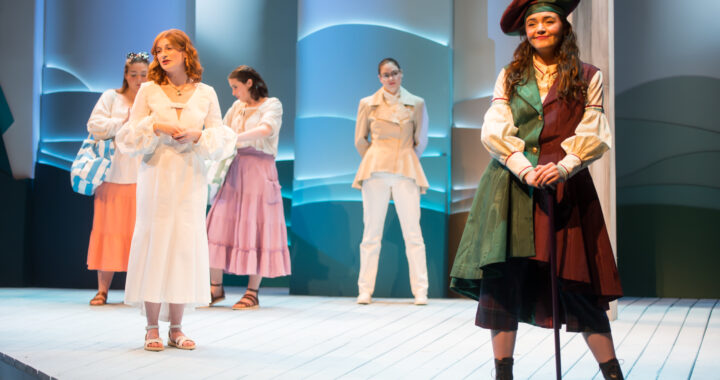“Cinderella” falls flat under recycled storyline
4 min readBy ALISON THOET
She sweeps into the ballroom, smile plastered on her face, glitter glued to skin and skirt alike, flitting about in a twinkling blue dress more full-bodied than an elephant’s behind. This is the new “Cinderella,” an over-the-top creation floating out of the head of Kenneth Branagh, perhaps one of the most over-the-top actors and directors there is.
Branagh does indeed bring the age-old fairytale to life, showing the back story of how little Ella become known as “Cinder-Ella.” We all know the story: mother and father die, the perfect angelic girl is tragically abused by the evil step-mother and sisters, then Cinderella (Lily James of “Downton Abbey”) is saved through her marriage to Prince Charming (Richard Madden of “Game of Thrones”). However, Branagh does have the insight to dig a little deeper and answer some questions for his 21st century viewers.
Unlike Disney’s original, the audience actually gets to see Cinderella’s mother, the fair-haired, tragic beauty that she is. Ella’s childhood is full of butterflies and love until her mother dies after a few pathetic coughs. Her father, unsuspecting dolt that he is, remarries. Now enter the most glorious character in the whole film: Cate Blanchett as Evil Stepmother, alias Lady Tremaine.
Her exquisite face shows all the contempt in the world for the young girl that her husband loves more than anything. Lady Tremaine is given more depth than the typical evil character (as is now in fashion with fairytale retellings, such as last summer’s “Maleficent”), and we learn of the death of the husband she really loved, which forced her to marry again in order to support her and her two perfectly ridiculous daughters.
Blanchett is draped in spectacular costumes that somehow match her coarse soul in color and form. Likewise, the evil stepsisters, Drisella (played by Sophie McShera of “Downton Abbey”) and Anastasia (Holliday Grainger), have their characters plastered on their bright, often matching, costumes that paint them as nothing short of petty and silly. Their “accomplishments” are few to none, though their hobbies include prattling on about nonsense and making fun of Cinderella. Regardless, the actresses put on a good show and provide some humor to the sometimes overly sentimental fantasy.
Branagh answers some questions that have long gone unanswered, including the whole glass slipper thing. In perhaps the greatest cameo of the film, Helena Bonham-Carter, as the bouncing and rather questionable fairy godmother, paints the shimmering shoes as “really comfortable” and explains that no one else can wear them because they are magically fitted to Cinderella herself.
The idea of love at first sight is also slightly tweaked in this version, as Cinderella meets the prince/future king while he hunts the largest CGI stag known to man. He stops her horse, she tells him to leave her friend the stag be and spouts out some notion of courage and kindness, which is constantly shoved down the viewers’ throats throughout the film. The prince, who introduces himself as “Kit” to hide his identity, is smitten, which explains why he decides to invite even the lowliest of women to his grand ball.
Cinderella gets to the ball with the help of a lizard and goose, both turned to men, and the quintessential pumpkin as a carriage drawn by four white mice who have been turned to horses. Evil Stepmother finds out, locks up the heroine and everyone tries on the glass slipper. But Kit’s smoldering blue eyes cannot be deceived and he finds his true love in the end.
We’ve seen it before. Yes, Branagh gives us a little more depth, but I’m not sure how well his sappy lines, costume dresses and silly CGI set “Cinderella” apart from all of the other Disney remakes that have been flooding our theatres as of late. I admit I enjoyed the film, or at least my inner always-wanted-to-be-princess child did, and I am sure it was a dream to girls of a certain age now, but I do not understand the point of rewriting a princess story if nothing is going to be changed.
Cinderella demonstrates the “have courage and be kind” motto, but that forces her into a mode of slavery in her own home. In addition, Disney is getting no better at creating the everyday princess. Lily James had to go on a partial liquid diet to fit into thimble-sized corsets. She is made heartbreakingly beautiful, and let’s be honest, no one is that nice.
I applaud Branagh for trying to break down the oh-so-complicated depth of Cinderella, but it seems he was more concerned with breaking the box office with a sappy, recycled hit, featuring a woman girls can only dream of becoming. If anything, the fairy tale was made less approachable for our generation than ever.












I very nicely written review which convinced me that I have better things to do with my time than to watch a rehashed Cinderella. However, it does not answer my burning question: Why the PG rating? Do the glass slippers reflect her underwear or something? (My daughter claims that they found an old rule book at the Catholic high school she attended saying that “nice girls” didn’t wear patent leather shoes for that very reason!) Would you let my great-granddaughter see it?